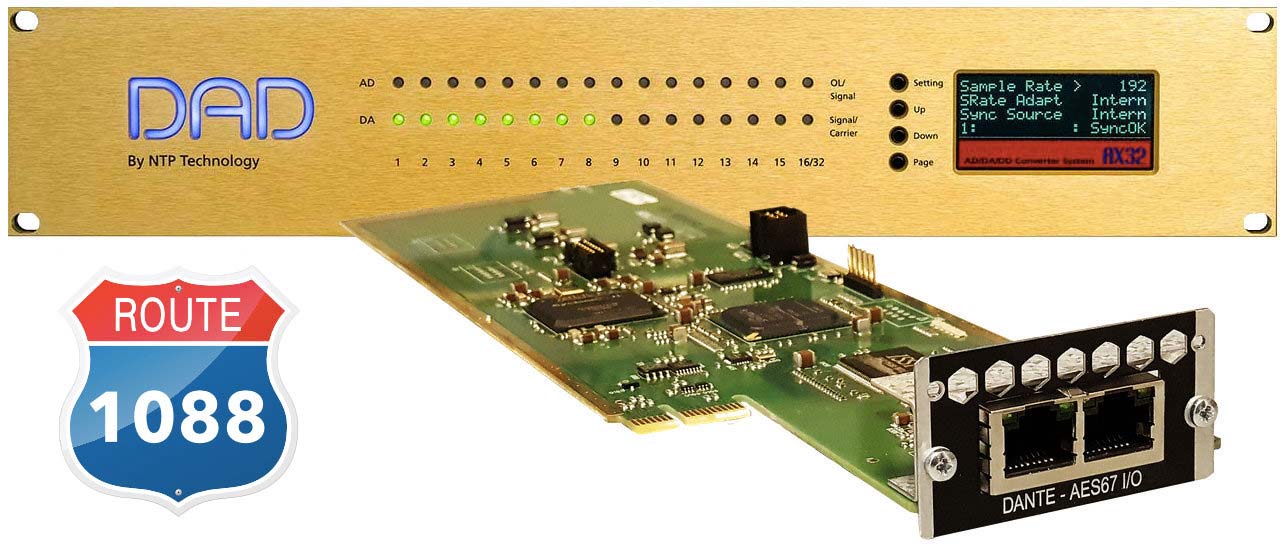Up to 1088 Dante/AES67 Channels
For DAD AX32R, Penta 720 & 721s Interfaces
AX32R already support 64 channels of Dante IP Audio via an optional module, but in an effort to meet demand for an even higher channel count, our an optional expansion card adds another 128 channels to your digital audio-routing matrix.
Further, with eight slots available for expansion cards, you could ultimately have up to 1,088 Dante/AES67 channels, including the 64 channels that comes as standard, at 48 kHz.
The Dante expansion card also offers sample rate conversion on all channels as well as dual redundancy network ports in order to maximize reliability, reducing the risk of losing valuable production time.
Independent Sample Rate Conversion
The Dante expansion card features per-card sample rate conversion, which by using more cards allows several independent audio networks that run on individual clocks and sample rates to be connected to and unified in a single AX32R unit.
This naturally unleashes a wealth of possibilities for distributing audio across sources and destinations on highly complex setups that e.g. involve sending a feed to an OB truck, while recording at a different sample rate and sending yet another feed to a FOH console or an in-ear monitoring system.
Simply adding more Dante channels may sound trivial, but once you start to think about the actual problems that this amount of channels in combination with independent sample rate conversion is capable of solving, it’s a quite significant improvement of the overall system.
For instance, the new Dante card will immediately be able to solve real-world challenges in regard to high channel counts when working with Dolby Atmos Mastering Suite, as well as in recording studios where Dante based monitoring systems are used, but there is a need to record at a different sample rate or in Live applications where there Dante networks have to be kept physically separated when operating on different clocks.
The internal sample rate converters on the new Dante cards have been developed in-house and we have never compromised on the quality of our AD/DA converters – or internal sample rate conversion within the digital domain. ‘Digital’ is simply part of our brand name and we take that very seriously!
Applications
- Live & Events
- Film Production (Dolby Atmos Mastering Suite)
- Broadcast
- Music Production
Features
- 128 channels @ 48 kHz / 64 channels @ 96 kHz / 32 channels @ 192 kHz
- Independent Sample Rate Conversion
- Dual Redundancy Ethernet Ports
- AES67 Support
- Up to 8 cards in a Single AX32R Mainframe
Multiple Operational Modes and Redundancy
The Dante card can operate either as a single 128×128 channel interface with a switch for the two Ethernet connectors or redundantly, where the two Ethernet connecters are connected to different networks each carrying 128×128 channels. If more cards are installed, each card can be connected to a different network or more cards can be connected to the same network via an external Ethernet switch or by bridging the network between the cards when operating in non-redundant mode.
The Dante card can operate in Dante mode or AES67 mode with support for discovery via SAP. In Dante mode, Dante Domain Manager (DDM) is supported for enhanced network management functionality. Configuration of the card is managed via DADman.
The block diagram of the Dante Card is shown below.
Sound on Sound’s Paul White stopped by our booth at AES to learn more about how the new Dante Card for AX32R, Penta 720 & 721s can help connecting AoIP networks that are physically separated. Thanks to the built in SRC (Sample Rate Conversion), several different IP Audio networks that operate on individual sample rates and digital master clocks can be unified and even share audio streams across the entire setup.
In this interview, our Business Development Manager, Jan Lykke, elaborates and gives a concrete example on how this may actually not be an extreme case, but a scenario that could easily solve real-world problems here and now for audio professionals all over the world.
Technical Specifications
- No. of channels: 128 channels @ 48 kHz, 64 channels @ 96 kHz, 32 channels @ 192 kHz
- Sample Rates: 44.1 kHz, 48 kHz, 88.2 kHz, 96 kHz, 176.4 kHz and 192 kHz
- Sample rate conversion (SRC): 128 channels bi-directional
- Dynamic Range SRC: > 125 dB
- SRC Processing: 64-bit Floating Point
- Audio Processing Delay: 1 Sample on the Card
- No. of Network Ports: Dual Ethernet, switched or redundant
- AoIP Format: Dante and AES67 with SAP Discovery
- Network Latency: 100 ns to 10 milliseconds
- Power Consumption: 4.5 W
- Connectors: 2 x RJ45




